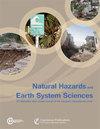哥伦比亚萨巴纳森特罗省住宅楼的地震风险情景
IF 4.7
2区 地球科学
Q1 GEOSCIENCES, MULTIDISCIPLINARY
引用次数: 2
摘要
摘要哥伦比亚位于地球上最活跃的地震带之一,纳斯卡板块、加勒比板块和南美板块在这里交汇。约83 % 全国人口中有一半生活在中高地震危险区,该国建筑业的很大一部分可以追溯到国家第一部抗震设计规范(1984年)之前。目前,该国主要城市都有地震风险情景,但仍有必要在其他地区进行此类研究。本文介绍了萨巴纳森特罗省的地震风险情景,该省是一个靠近该国首都的中等危险区。结合全球地震模型基金会、调查和国家人口普查的信息,创建了一个暴露模型。脆弱性和脆弱性曲线被分配给该地区的建筑类型。为该地区开发了一个灾害模型,并使用OpenQuake(OQ)灾害和风险评估工具模拟了重现期为475年的18种地震情景,以估计损失和经济损失。此外,基于人口统计信息的社会脆弱性指数(SVI)用于评估重置成本方面的直接经济损失。结果表明 % 在该地区考虑的所有建筑中,有7座将倒塌 % 将遭受严重损害。损失占14 % 占建筑物总重置成本的21 % 占该地区年度国内生产总值的百分比。本文章由计算机程序翻译,如有差异,请以英文原文为准。
Seismic risk scenarios for the residential buildings in the Sabana Centro province in Colombia
Abstract. Colombia is in one of the most active seismic zones on
Earth, where the Nazca, Caribbean, and South American plates converge.
Approximately 83 % of the national population lives in intermediate to
high seismic hazard zones, and a significant part of the country's building
inventory dates from before the nation's first seismic design code (1984).
At present, seismic risk scenarios are available for the major cities of the country, but there is still a need to undertake such studies in other
regions. This paper presents a seismic risk scenario for the Sabana
Centro province, an intermediate hazard zone located close to the
country's capital. An exposure model was created combining information from
the Global Earthquake Model (GEM) Foundation, surveys, and the national
census. Fragility and vulnerability curves were assigned to the building
types of the region. A hazard model was developed for the region and
18 earthquake scenarios with a return period of 475 years were
simulated using the OpenQuake (OQ) hazard and risk assessment tool to
estimate damage and economic losses. In addition, a social vulnerability
index (SVI) based on demographic information was used to assess the direct
economic loss in terms of replacement costs. The results show that 10 % of all buildings considered in the region would experience collapse, and 7 % would suffer severe damage. Losses account for 14 % of the total replacement cost of the buildings and represent 21 % of the annual gross domestic product (GDP) of the region.
求助全文
通过发布文献求助,成功后即可免费获取论文全文。
去求助
来源期刊
CiteScore
7.60
自引率
6.50%
发文量
192
审稿时长
3.8 months
期刊介绍:
Natural Hazards and Earth System Sciences (NHESS) is an interdisciplinary and international journal dedicated to the public discussion and open-access publication of high-quality studies and original research on natural hazards and their consequences. Embracing a holistic Earth system science approach, NHESS serves a wide and diverse community of research scientists, practitioners, and decision makers concerned with detection of natural hazards, monitoring and modelling, vulnerability and risk assessment, and the design and implementation of mitigation and adaptation strategies, including economical, societal, and educational aspects.

 求助内容:
求助内容: 应助结果提醒方式:
应助结果提醒方式:


